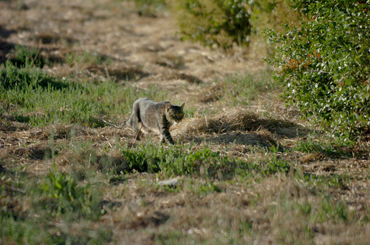
Feral cats face perils when not cared for by shelters,
volunteers
Feral cats
– the skinny, sometimes matted, often sickly creatures that
gather around dumpsters in apartment complexes and behind retail
stores – are not a problem unique to Santa Clara and San Benito
counties. The same straggly cats gather in business parks and town
centers everywhere.
Feral cats face perils when not cared for by shelters, volunteers
Feral cats – the skinny, sometimes matted, often sickly creatures that gather around dumpsters in apartment complexes and behind retail stores – are not a problem unique to Santa Clara and San Benito counties. The same straggly cats gather in business parks and town centers everywhere.
“There is a problem with feral cats in the United States – period,” said Julie Carreiro, the supervisor of the Hollister Animal Shelter.
For many counties, their way of dealing with the feral problem often comes down to euthanizing them when they are brought into shelters. As many as 14,000 feral cats are put to death in Santa Clara county alone – but the feral cat population continues to grow with estimates of as many as 100,000 ferals living in Santa Clara County, according to the Santa Clara County Board of Supervisors. The Board of Supervisors declared 2006 the year of the feral cat in hopes of educating residents about the problem.
Cats are euthanized at a greater rate than other animals that come into Santa Clara shelters, according to Humane Society Silicon Valley President Christine Benninger. Cats that are feral, kittens that are still nursing or felines too sick to be adopted cost the county as much as $2.4 million a year just to euthanize them.
“Rounding up cats and euthanizing them does not solve the problem and in fact creates a void for new cats to fill and continue the breeding cycle,” Benninger said.
Carreiro, Benninger and others working with feral cats promote “trap-neuter-release” programs as the best way to curb the feral cat population. But programs like these are hard to start because they require the cooperation of government, nonprofits and property owners.
Town Cats of Morgan Hill, a nonprofit cat rescue group, maintains a T-N-R program and educates the public on how to handle ferals. Founder and director Rosi Mirko started working with feral cats in 1998 when a few cats showed up around her insurance office in Morgan Hill. She started out trapping a few cats near her office, taking them in to be spayed or neutered and vaccinated, and then releasing them back into their territory.
“Some of these cats have been here since 1997,” Mirko said. “We never see any kittens now.”
Mirko and 25 active Town Cats volunteers now maintain 20 feral cat colonies in Morgan Hill – most with just two to to cats each – and five in Gilroy. They also run a private shelter, licensed for 90 cats or kittens, and hold regular adoption fairs.
Most of the cats in Mirko’s colonies stay out of sight when people are around and only one, Apache, a Siamese-tabby mix is friendly enough to let Mirko pet him, though he hisses at other people.
When not taken care of, feral cats live short lives and can pass along infectious illnesses to other cats or wildlife. They can also have negative effects on other wildlife and bird populations. In 1997, the National Audubon adopted a policy to educate people about the impact of feral cats and free-ranging domestic cats on birds.
“The policy was based on a fair amount of scientific study that found feral and free-ranging domestic cats seem to have about 20-30 percent of their prey from native birds,” said Bob Power, the executive director of the Santa Clara Valley Audubon Society. “Studies have shown that they have a significant negative impact.”
With that said, Power felt T-N-R programs were one way to handle the feral cat problem.
“It reduces future generations so you don’t have litters of feral cats cropping up,” Power said.
An integral part of feral cat colony management, such as Mirko’s, is providing food and water for the animals. At one site, two cats came bounding toward plastic food tubs after Mirko filled them with Science Diet cat food. Anecdotally, Mirko said she finds that her feral cats do very little hunting of birds – she rarely finds the telltale signs of feathers and bones around her cat colonies.
“They are too lazy,” Mirko said. “Cats are opportunistic. That’s why they survive so well. Most of what they eat is out of dumpsters. Birds are hard to catch.”
Town Cats provides the necessary tools and training to trap feral cats.
“When people call us, we try to recruit them as volunteers,” Mirko said. “If they are calling us, its because they don’t want to put the cats to sleep.”
Santa Clara County also offers a low-cost spay/neuter and vaccine program for feral cats to prompt people to bring cats in and then releas them. But despite the small efforts, ferals remain a problem for local shelters.
A tiny pastel calico kitten came to the Hollister Animal Shelter July 18 covered in fleas, nearly dead from the bites. A week later, after a flea bath and regular medication, the 5-6-week-old baby is doing well enough to clean herself, one of the first signs that a sick cat is feeling better.
“She was so full of fleas, she had become completely anemic,” Carreiro said. “She wouldn’t eat and she was so tiny and frail and so pale…It’s a prime example of what happens when ferals are not spayed or neutered.”
The small calico is one of the lucky kittens that came in old enough to eat dry food. For many shelters, volunteer efforts are needed to keep prewean kittens alive. The Hollister animal shelter has a “nursing animal network,” but a shortage of volunteers mean that many young animals will not survive.
“We don’t have enough volunteers for the number of kittens that come in,” Carreiro said.
The Hollister Animal Shelter takes in about 1,500 cats a year and at least 500 feral cats are euthanized each year.
The San Martin Animal Shelter faces the same challenge. When feral kittens come in with a mother, the adoption rate for the kittens is high, according to Fletcher Dobbs, Santa Clara County Animal Care and Control program manager.
San Martin Animal Shelter, which handled 2,000 cats in the 2005-2006 fiscal year, tries to adopt out all the cats that come through its doors.
“It absolutely is our intent to find homes for all the animals we bring into the shelter, but that isn’t always possible,” Dobbs said. “It isn’t easy to place a feral cat. Animals brought in are assessed for their adoptability, or compatibility of being kept as a barn cat or a house cat.”
Some ferals are adopted as barn cats for $25. Barn cats are often adopted to be “working cats,” or mousers on ranches and farms.
Nursing kittens without a mother stand little chance without the help of volunteers.
“We have a terrific volunteer network that we rely on specifically during cat season,” Dobbs said, of working with preweans. “There is a lot of work and a lot of time and effort that goes into bottle feeding these animals.”
Like Hollister’s shelter, San Martin’s has a high success rate in adopting out kittens, even those born as ferals.
“The good news is, if we can get them successfully brought to weight and get them through spay and neuter, they usually get adopted,” Dobbs said.
Humane Society Silicon Valley and Jump Cutters Video recently released a documentary entitled “Cats Without a Home,” about the plight of feral cats in Santa Clara County. To view a trailer of the film, visit www.catswithoutahome.com.
The 30-minute film will air on NBC-11 on the following dates: Saturday, July 29 at 11:30 a.m.; Sunday, July 30 at 10:30 a.m.; and Saturday, August 5 at 11 a.m.









